A Numerical Investigation of the Effects of the Fuel Injection Pressure and Nozzle Hole Diameter on Natural Gas–Diesel Dual-Fuel Combustion Characteristics
Abstract
1. Introduction
2. Simulation Methodology and Matrix
2.1. Numerical Model of Engine
2.2. Numerical Model of Spray Box
2.3. Simulation Matrix
3. Results and Discussions
3.1. Validation of the Numerical Models
3.2. Effects of Injection Pressure
3.3. Effects of NHD Variations
3.4. Evaluation of Simulated Matrix
4. Conclusions
- An increase in injection pressure causes excessively advanced combustion under 0% and 25% NGEF conditions. Increased HRR before TDC leads to higher cylinder pressures and work. As a result, MEP values decrease in 0% and 25% NGEF conditions. The only positive effect of increased injection pressure is a reduction in soot emissions at 0% and 25% NGEF. Additionally, a reduction in NHD from 230 μm to 150 μm does not improve MEP values. Although substantial improvements in engine performance are not observed, optimal injection pressure and NHD values can significantly reduce MPRR, NOX, and soot emissions.
- Unlike at 0% and 25% NGEF, MEP improves by up to 4.6% under 50% NGEF conditions. MEP values increase with a rise in injection pressures. However, no additional improvement is observed as NHD decreases. The highest MPRR levels are observed under 50% NGEF conditions. At higher injection pressures and larger NHD values, MPRR exceeds the allowable limit. Therefore, a combination of higher injection pressures and smaller NHD values is preferable. In this way, compliance with the MPRR limit and soot regulations can be achieved. In brief, a combination of 190 μm NHD and 90 MPa injection pressure provides an ITE of 2% lower than the highest ITE case. However, soot emissions are significantly lower than diesel conditions allowing compliance with soot regulations without requiring an exhaust after-treatment system.
- The effects of injection pressure and NHD variation at 75% NGEF differ from those in lower NGEF conditions. The baseline CA50 value is delayed significantly at 75% NGEF, depending on reduced combustion rates. An increase in injection pressure substantially improves the combustion rates, MEP values, and efficiency at 75% NGEF. When the injection pressure increases from 32 MPa to 126 MPa, MEP increases by 6.7%. However, injection durations are further shortened under high-NGEF, high injection pressure, and larger-NHD conditions. These shortened injection durations introduce challenges in combustion control and stability.
- At 75% NGEF and injection pressures of 90 and 126 MPa, reducing NHD values increases the injection duration and velocity. This improves the mixing between premixed natural gas–air and diesel spray. As a result, reducing NHD from 230 μm further enhances engine performance. MEP increases with decreasing NHD up to a certain point, and then it declines. The highest MEP is achieved with the combination of 126 MPa and 150 μm. Improvement in MEP reaches 9.8% compared to the baseline. Under these conditions, the thermal efficiency is equivalent to that of a diesel engine. This improvement also results in a 77% reduction in CH4 emissions. This value is equivalent to 2.7% of the fuel mass, and it is lower than the FuelEU methane slip criterion of 3.1%. Moreover, soot emission regulations are satisfied without the need for a DPF system. Additionally, MPRR values are lower than the 13 bar/degree limit. Finally, this condition results in the lowest total GHG emissions among the NDDF cases considered in this study.
- Finally, using smaller NHD values at 75% NGEF enhances combustion control and stability. CA90 values and CH4 mass fraction images indicate that combustion rates are more stable at lower NHD values. Additionally, relative MEP changes indicate that combustion performance is highly sensitive to injection parameters under high-NGEF conditions. Therefore, the results indicate the need for more precise injector control to achieve stable operation. The use of smaller NHD is also advantageous in this regard as it increases injection durations.
Author Contributions
Funding
Data Availability Statement
Conflicts of Interest
Abbreviations
| NDDF | Natural Gas Diesel Dual-Fuel. |
| NHD | Nozzle Hole Diameter. |
| NGEF | Natural Gas Energy Fraction. |
| CH4 | Methane. |
| NOx | Nitrogen Oxide. |
| SOx | Sulphur Oxide. |
| CO2 | Carbon Dioxide. |
| PM | Particulate Matter. |
| ICE | Internal Combustion Engine. |
| GHG | Greenhouse Gas. |
| UHC | Unburned Hydrocarbon. |
| MPRR | Maximum Pressure Rise Rate. |
| IVC | Intake Valve Closure. |
| EVO | Exhaust Valve Opening. |
| LHV | Lower Heating Value. |
| DFM | Dual-Fuel Chemical Mechanism. |
| MEP | Mean Effective Pressure. |
| BMEP | Brake Mean Effective Pressure. |
| HRR | Heat Release Rate. |
| TDC | Top Dead Center. |
| CA | Crank Angle. |
| ITE | Indicated Thermal Efficiency. |
Appendix A
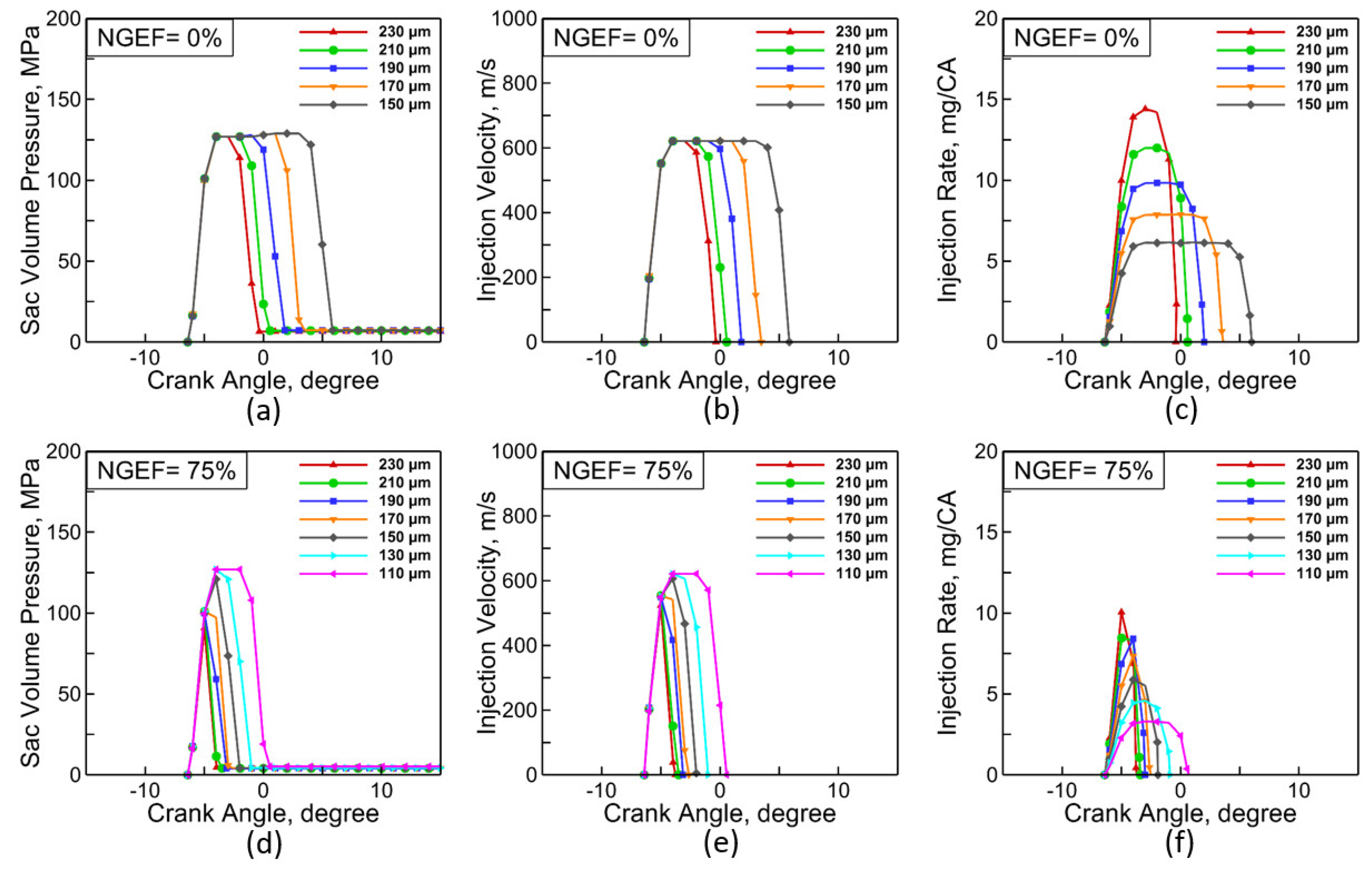
References
- Reşitoğlu, İ.A.; Altinişik, K.; Keskin, A. The Pollutant Emissions from Diesel-Engine Vehicles and Exhaust Aftertreatment Systems. Clean Technol. Environ. Policy 2015, 17, 15–27. [Google Scholar] [CrossRef]
- Endresen, Ø.; Eide, M.; Dalsøren, S.; Isaksen, I.; Sørgård, E.; Corbett, J.; Winebrake, J. International Maritime Shipping: Environmental Impacts of Increased Activity Levels. In Globalisation, Transport and the Environment; OECD: Paris, France, 2010; pp. 161–184. ISBN 978-92-64-07919-9. Available online: https://www.oecd.org/en/publications/globalisation-transport-and-the-environment_9789264072916-en.html (accessed on 24 February 2025).
- Ni, P.; Wang, X.; Li, H. A Review on Regulations, Current Status, Effects and Reduction Strategies of Emissions for Marine Diesel Engines. Fuel 2020, 279, 118477. [Google Scholar] [CrossRef]
- Reis, H.; Reis, C.; Sharip, A.; Reis, W.; Zhao, Y.; Sinclair, R.; Beeson, L. Diesel Exhaust Exposure, Its Multi-System Effects, and the Effect of New Technology Diesel Exhaust. Environ. Int. 2018, 114, 252–265. [Google Scholar] [CrossRef] [PubMed]
- Dornoff, J.; Rodríguez, F. Euro 7: The New Emission Standard for Light- and Heavy-Duty Vehicles in the European Union. 2024. Available online: https://theicct.org/publication/euro-7-emission-standard-ldv-hdv-eu-mar24/ (accessed on 24 February 2025).
- Fuel EU Maritime Regulation (EU) 2023/1805 of the European Parliament and of the Council of 13 September 2023 on the Use of Renewable and Low-Carbon Fuels in Maritime Transport, and Amending Directive 2009/16/EC. 2009, Volume 188. Available online: https://eur-lex.europa.eu/eli/reg/2023/1805/oj/eng (accessed on 24 February 2025).
- Tolley, A. Heavy-Duty Vehicles and Powertrains: Future Internal Combustion Engine Systems and Technologies. In Alternative Fuels and Advanced Vehicle Technologies for Improved Environmental Performance; Elsevier: Amsterdam, The Netherlands, 2022; pp. 291–351. ISBN 978-0-323-90979-2. [Google Scholar]
- Curran, S.; Onorati, A.; Payri, R.; Agarwal, A.K.; Arcoumanis, C.; Bae, C.; Boulouchos, K.; Dal Forno Chuahy, F.; Gavaises, M.; Hampson, G.J.; et al. The Future of Ship Engines: Renewable Fuels and Enabling Technologies for Decarbonization. Int. J. Engine Res. 2024, 25, 85–110. [Google Scholar] [CrossRef]
- Agarwal, A.K.; Singh, A.P.; Maurya, R.K. Evolution, Challenges and Path Forward for Low Temperature Combustion Engines. Prog. Energy Combust. Sci. 2017, 61, 1–56. [Google Scholar] [CrossRef]
- Reitz, R.D.; Duraisamy, G. Review of High Efficiency and Clean Reactivity Controlled Compression Ignition (RCCI) Combustion in Internal Combustion Engines. Prog. Energy Combust. Sci. 2015, 46, 12–71. [Google Scholar] [CrossRef]
- AEsoy, V.; Magne Einang, P.; Stenersen, D.; Hennie, E.; Valberg, I. LNG-Fuelled Engines and Fuel Systems for Medium-Speed Engines in Maritime Applications. In SAE Technical Paper 2011-01-1998; SAE International: Warrendale, PA, USA, 2011. [Google Scholar]
- Karim, G.A. Dual-Fuel Diesel Engines, 1st ed.; Taylor & Francis Group: London, UK, 2015; ISBN 978-1-4987-0309-3. [Google Scholar]
- Cui, Z.; Liu, Y.; Zhang, X.; Zhou, Q.; Yang, H.; Lu, M.; Tian, J. Visualization Study on the Ignition and Combustion Characteristics of Methane/Hydrogen Ignited by Diesel. Fuel 2024, 372, 132215. [Google Scholar] [CrossRef]
- Tripathi, G.; Dhar, A. Performance, Emissions, and Combustion Characteristics of Methane-Diesel Dual-Fuel Engines: A Review. Front. Therm. Eng. 2022, 2, 870077. [Google Scholar] [CrossRef]
- Liu, J.; Zhao, W.; Zhang, X.; Ji, Q.; Ma, H.; Sun, P.; Wang, P. Optimizing Combustion and Emissions in Natural Gas/Diesel Dual-Fuel Engine with Pilot Injection Strategy. Therm. Sci. Eng. Prog. 2024, 48, 102418. [Google Scholar] [CrossRef]
- Lee, S.; Kim, C.; Lee, S.; Lee, J.; Kim, J. Diesel Injector Nozzle Optimization for High CNG Substitution in a Dual-Fuel Heavy-Duty Diesel Engine. Fuel 2020, 262, 116607. [Google Scholar] [CrossRef]
- Wei, L.; Geng, P. A Review on Natural Gas/Diesel Dual Fuel Combustion, Emissions and Performance. Fuel Process. Technol. 2016, 142, 264–278. [Google Scholar] [CrossRef]
- Liu, J.; Yao, A.; Yao, C. Effects of Diesel Injection Pressure on the Performance and Emissions of a HD Common-Rail Diesel Engine Fueled with Diesel/Methanol Dual Fuel. Fuel 2015, 140, 192–200. [Google Scholar] [CrossRef]
- Yalong, L.; Bo, W.; Cong, W.; Zhi, J.; Binyang, W. The Effect of Ignition Diesel Injection Conditions on the Combustion Process of Natural Gas Engine. Appl. Therm. Eng. 2023, 235, 121452. [Google Scholar] [CrossRef]
- Bonfochi Vinhaes, V.; McTaggart-Cowan, G.; Munshi, S.; Shahbakhti, M.; Naber, J.D. Experimental Studies of Low-Load Limit in a Stoichiometric Micro-Pilot Diesel Natural Gas Engine. Energies 2022, 15, 728. [Google Scholar] [CrossRef]
- Baumgarten, C. Mixture Formation in Internal Combustion Engines; Heat and mass transfer; Springer: Berlin, Germany, 2006; ISBN 978-3-540-30835-5. [Google Scholar]
- Wang, X.; Li, H.; Li, G.; Fan, J.; Bai, H.; Gao, Y.; Huo, H. Effect of Injection Pressure on Low-Temperature Fuel Atomization Characteristics of Diesel Engines under Cold Start Conditions. Int. J. Multiph. Flow 2024, 172, 104712. [Google Scholar] [CrossRef]
- Yousefi, A.; Guo, H.; Birouk, M.; Liko, B. On Greenhouse Gas Emissions and Thermal Efficiency of Natural Gas/Diesel Dual-Fuel Engine at Low Load Conditions: Coupled Effect of Injector Rail Pressure and Split Injection. Appl. Energy 2019, 242, 216–231. [Google Scholar] [CrossRef]
- Niki, Y.; Rajasegar, R.; Li, Z.; Musculus, M.P.; Garcia Oliver, J.M.; Takasaki, K. Verification of Diesel Spray Ignition Phenomenon in Dual-Fuel Diesel-Piloted Premixed Natural Gas Engine. Int. J. Engine Res. 2022, 23, 180–197. [Google Scholar] [CrossRef]
- Pedrozo, V.B.; May, I.; Guan, W.; Zhao, H. High Efficiency Ethanol-Diesel Dual-Fuel Combustion: A Comparison against Conventional Diesel Combustion from Low to Full Engine Load. Fuel 2018, 230, 440–451. [Google Scholar] [CrossRef]
- Zhang, Z.; Xu, C. Study on Influencing Factors and Laws of Fuel Injection Consistency of Common Rail Injector. J. Phys. Conf. Ser. 2021, 2097, 012001. [Google Scholar] [CrossRef]
- Yoon, M.; Choi, M.; Kang, K.; Oh, C.; Park, Y.; Choi, G. Effects of N-Heptane/Methane Blended Fuel on Ignition Delay Time in Pre-Mixed Compressed Combustion. Energies 2022, 15, 4081. [Google Scholar] [CrossRef]
- Zheng, J.; Hao, Z.; Wang, D.; Di, Y.; Peng, H.; Wu, T.; Miao, X. Effect of Double-Layer Hole Nozzle with Narrow Spray Angle on Combustion and Emissions in Dual-Fuel Natural Gas Engine. Fuel 2022, 314, 123090. [Google Scholar] [CrossRef]
- Hariharan, D.; Rajan Krishnan, S.; Kumar Srinivasan, K.; Sohail, A. Multiple Injection Strategies for Reducing HC and CO Emissions in Diesel-Methane Dual-Fuel Low Temperature Combustion. Fuel 2021, 305, 121372. [Google Scholar] [CrossRef]
- Guo, H.; Neill, W.S.; Liko, B. An Experimental Investigation on the Combustion and Emissions Performance of a Natural Gas–Diesel Dual Fuel Engine at Low and Medium Loads. In Proceedings of the Volume 1: Large Bore Engines, Fuels, Advanced Combustion; American Society of Mechanical Engineers, Houston, TX, USA, 8 November 2015; p. V001T03A005. [Google Scholar]
- Li, Y.; Li, H.; Guo, H.; Li, Y.; Yao, M. A Numerical Investigation on Methane Combustion and Emissions from a Natural Gas-Diesel Dual Fuel Engine Using CFD Model. Appl. Energy 2017, 205, 153–162. [Google Scholar] [CrossRef]
- ANSYS® Forte, 2021 R1, Forte Theory Guide; ANSYS, Inc.: Canonsburg, PA, USA, 2021.
- Healy, D.; Kalitan, D.M.; Aul, C.J.; Petersen, E.L.; Bourque, G.; Curran, H.J. Oxidation of C1−C5 Alkane Quinternary Natural Gas Mixtures at High Pressures. Energy Fuels 2010, 24, 1521–1528. [Google Scholar] [CrossRef]
- Wang, H.; Jiao, Q.; Yao, M.; Yang, B.; Qiu, L.; Reitz, R.D. Development of an N-Heptane/Toluene/Polyaromatic Hydrocarbon Mechanism and Its Application for Combustion and Soot Prediction. Int. J. Engine Res. 2013, 14, 434–451. [Google Scholar] [CrossRef]
- Gao, Z.; Li, G.; Xu, C.; Li, H.; Wang, M. A Calculation Method and Experiment Study of High-Pressure Common Rail Injection Rate with Solenoid Injectors. Sci. Prog. 2021, 104, 00368504211026157. [Google Scholar] [CrossRef]
- Salvador, F.J.; Gimeno, J.; De La Morena, J.; Carreres, M. Using One-Dimensional Modeling to Analyze the Influence of the Use of Biodiesels on the Dynamic Behavior of Solenoid-Operated Injectors in Common Rail Systems: Results of the Simulations and Discussion. Energy Convers. Manag. 2012, 54, 122–132. [Google Scholar] [CrossRef]
- Xu, J.; Fan, L.; Chen, C.; Lu, G.; Li, B.; Tu, T. Study on Fuel Injection Stability Improvement in Marine Low-Speed Dual-Fuel Engines. Appl. Therm. Eng. 2024, 253, 123729. [Google Scholar] [CrossRef]
- Kang, S.; Lee, S.; Hong, D.; Bae, C. Effects of Nozzle Orifice Diameter and Hole Number on Diesel Combustion and Engine Performance. Int. J. Automot. Technol. 2022, 23, 481–494. [Google Scholar] [CrossRef]
- Tanner, F.X.; Reitz, R.D. Scaling Aspects of the Characteristic Time Combustion Model in the Simulation of Diesel Engines. In SAE Technical Paper 1999-01-1175; SAE International: Warrendale, PA, USA, 1999. [Google Scholar]
- Montgomery, D.T.; Chan, M.; Chang, C.T.; Farrell, P.V.; Reitz, R.D. Effect of Injector Nozzle Hole Size and Number on Spray Characteristics and the Performance of a Heavy Duty D.I. Diesel Engine. In SAE Technical Paper 962002; SAE International: Warrendale, PA, USA, 1996. [Google Scholar]
- Yousefi, A. A Numerical Study of the Combustion of a Natural Gas/Diesel Dual-Fuel Engine Under Low to High Load Conditions. 2018. Available online: https://www.researchgate.net/publication/325876970_A_Numerical_Study_of_the_Combustion_of_a_Natural_GasDiesel_Dual-Fuel_Engine_under_Low_to_High_Load_Conditions (accessed on 24 February 2025).
- Soruşbay, C.; Ergeneman, M.; İmren, A.; Çalık, A.T. Experimental and Numerical Air Flow and Spray Dynamics Investigation in Internal Combustion Engines; İstanbul, Türkiye. 2008; p. 38. Available online: https://search.trdizin.gov.tr/en/yayin/detay/608313/experimental-and-numerical-air-flow-and-spray-dynamics-investigation-in-internal-combustion-engines (accessed on 24 February 2025).
- İmren, A. The Full Operating Cycle Modeling of Heavy-Duty Diesel Engines. Ph.D. Thesis, Istanbul Technical University, İstanbul, Türkiye, 2010. [Google Scholar]
- Chan, M.; Das, S.; Reitz, R.D. Modeling Multiple Injection and EGR Effects on Diesel Engine Emissions. In SAE Technical Paper 972864; SAE International: Warrendale, PA, USA, 1997. [Google Scholar]
- Baek, H.-M.; Jung, G.-S.; Vuong, Q.D.; Lee, J.-U.; Lee, J.-W. Effect of Performance by Excessive Advanced Fuel Injection Timing on Marine Diesel Engine. Appl. Sci. 2023, 13, 9263. [Google Scholar] [CrossRef]
- Dallmann, T.R.; Onasch, T.B.; Kirchstetter, T.W.; Worton, D.R.; Fortner, E.C.; Herndon, S.C.; Wood, E.C.; Franklin, J.P.; Worsnop, D.R.; Goldstein, A.H.; et al. Characterization of Particulate Matter Emissions from On-Road Gasoline and Diesel Vehicles Using a Soot Particle Aerosol Mass Spectrometer. Atmospheric Chem. Phys. 2014, 14, 7585–7599. [Google Scholar] [CrossRef]
- Sagot, B.; Giraudier, G.; Decuniac, F.; Lefebvre, L.; Miquel, A.; Thomas, A. On-Board Measurement of Emissions on a Dual Fuel LNG Powered Cruise Ship: A Sea Trial Study. Atmospheric Environ. X 2025, 25, 100313. [Google Scholar] [CrossRef]
- U.S. EPA Importance of Methane. Available online: https://www.epa.gov/gmi/importance-methane (accessed on 31 January 2025).
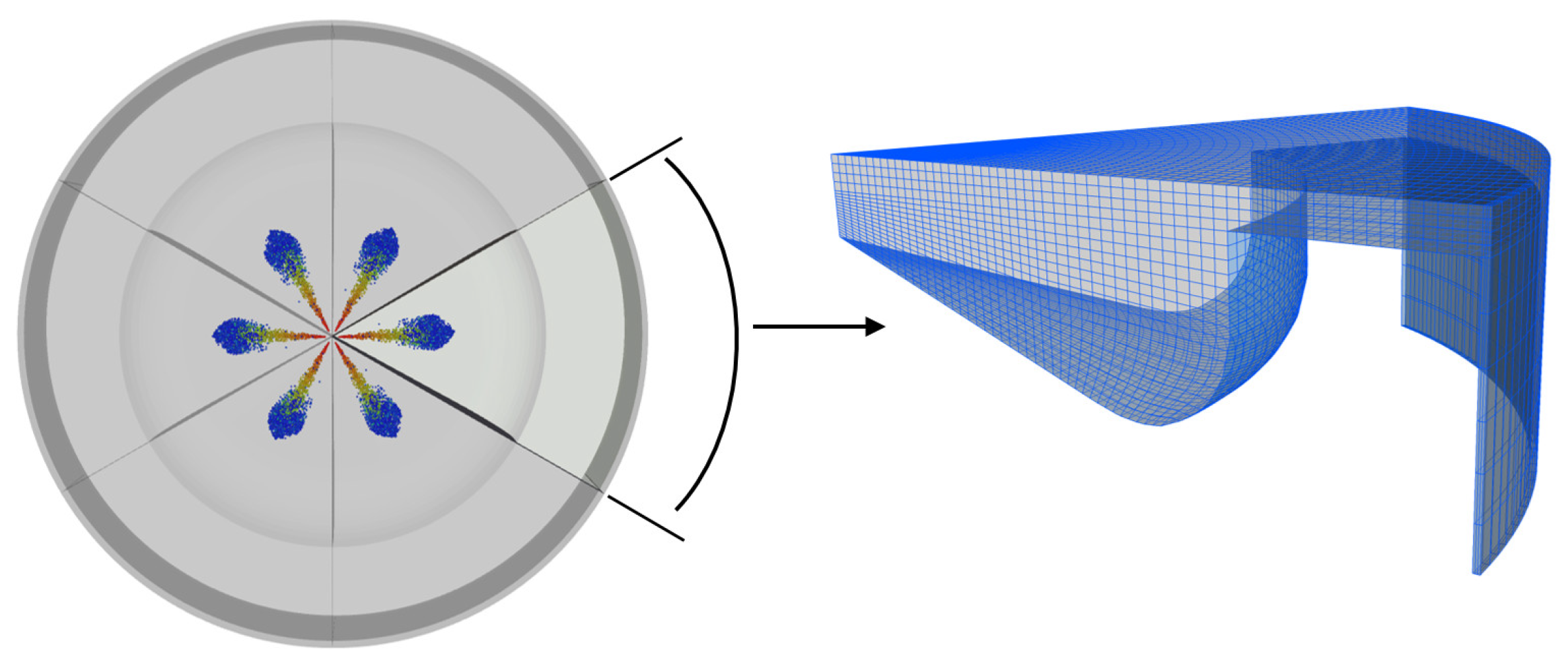
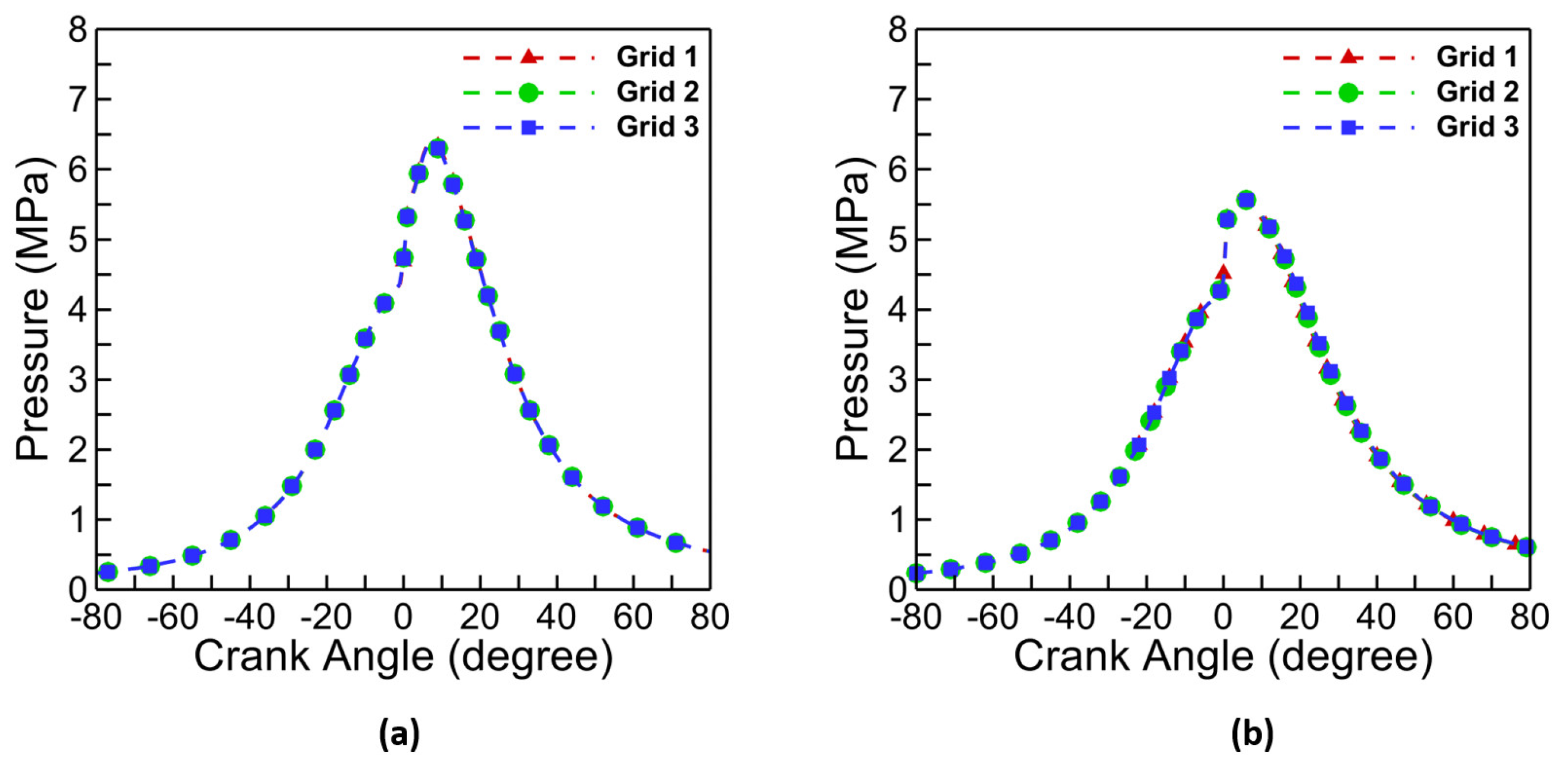

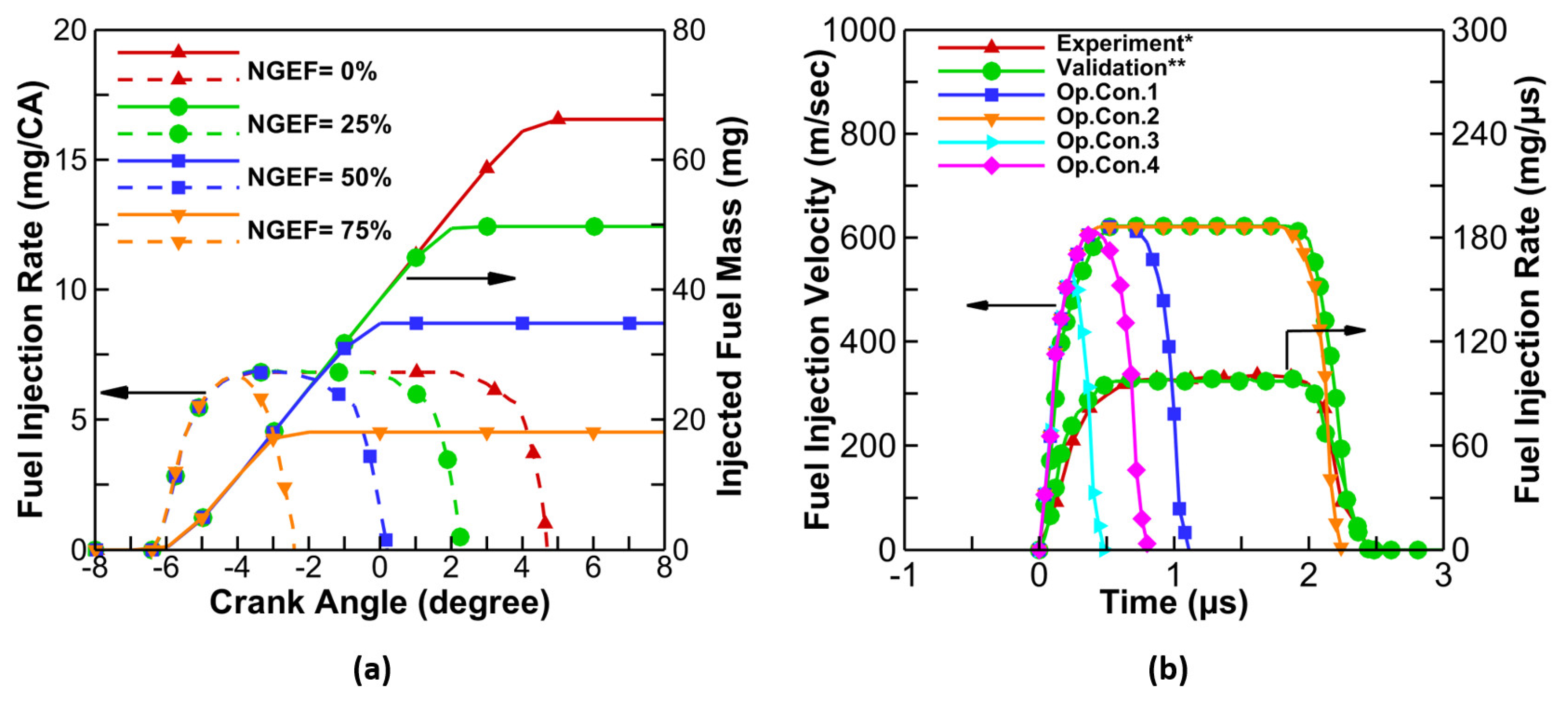
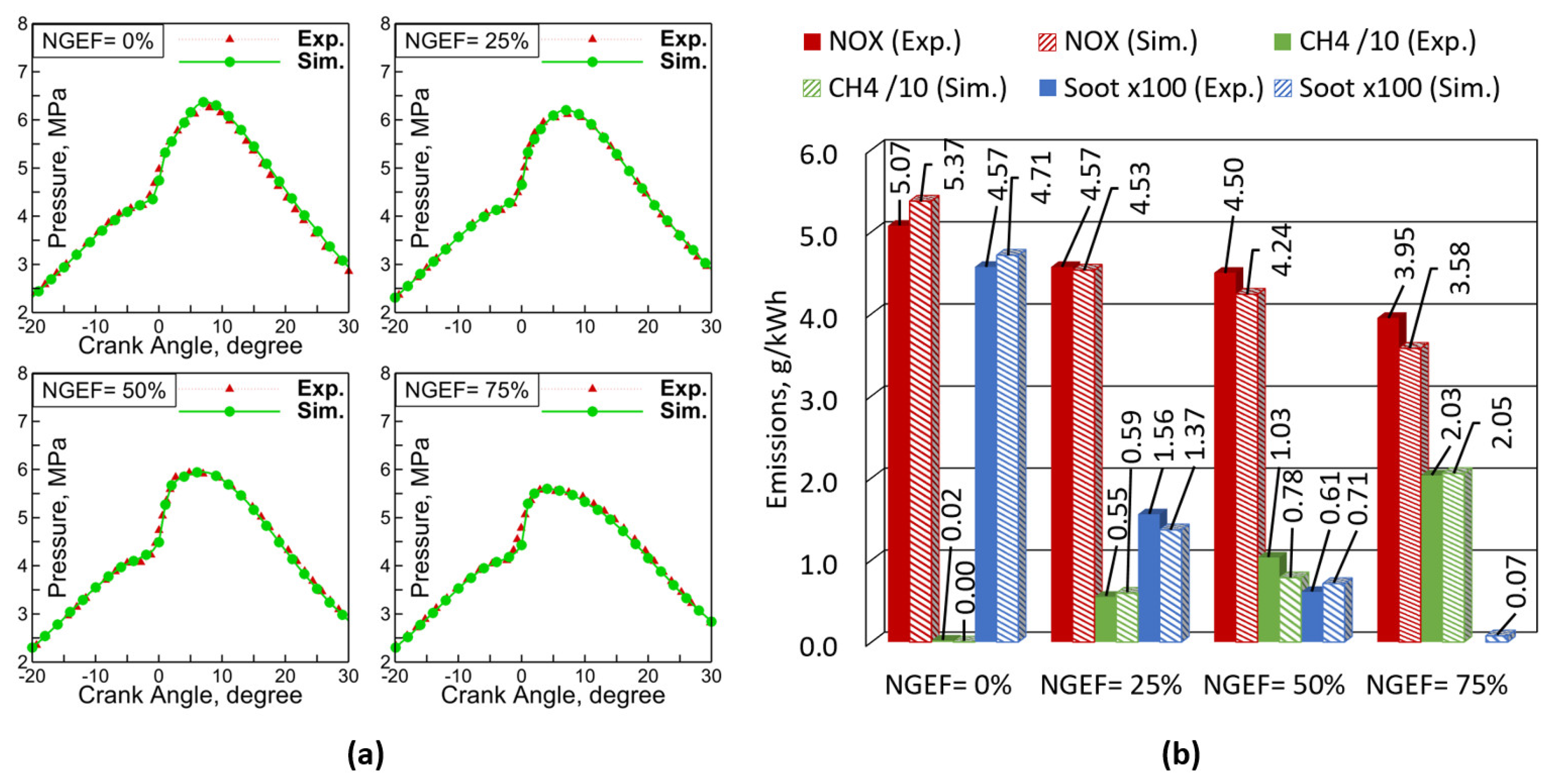
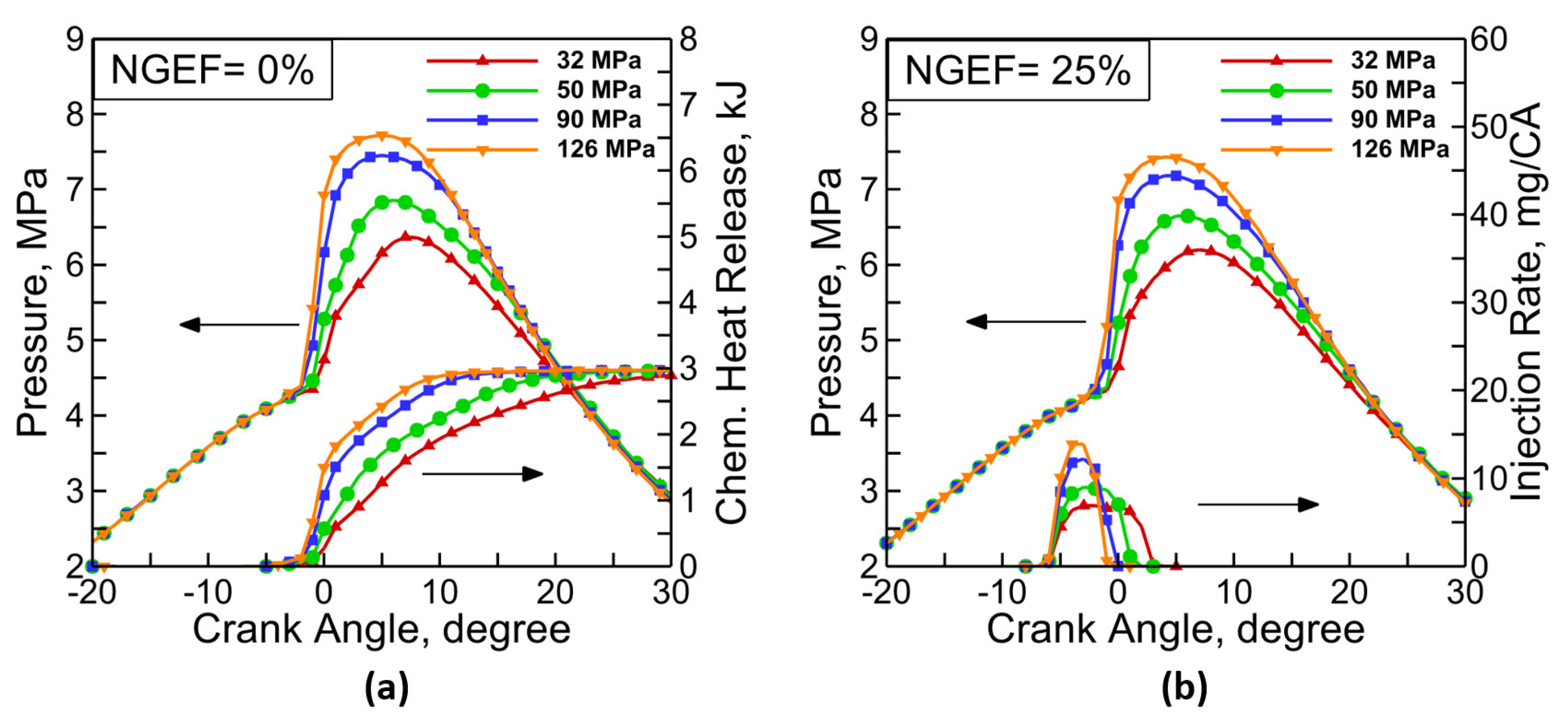
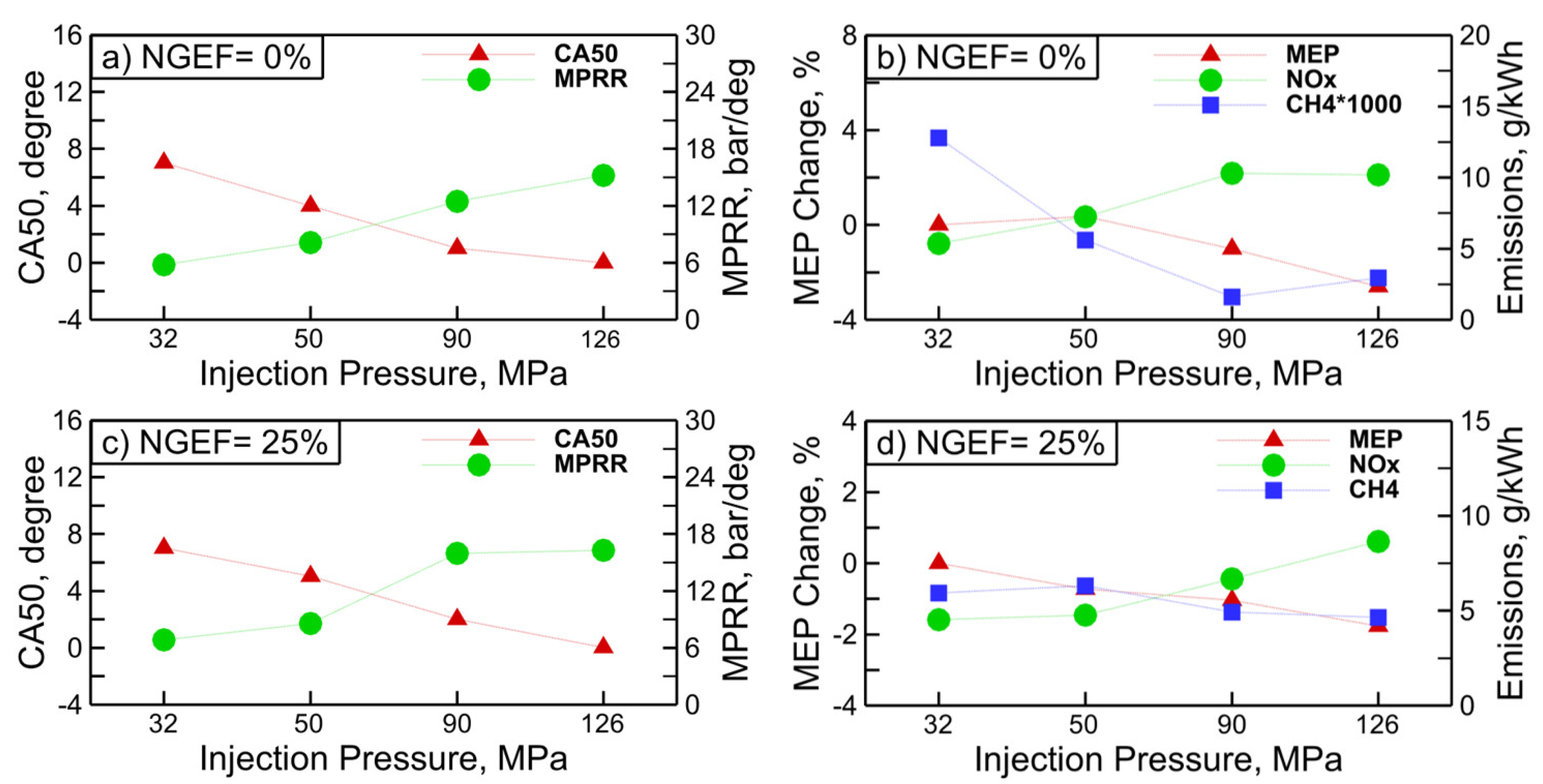
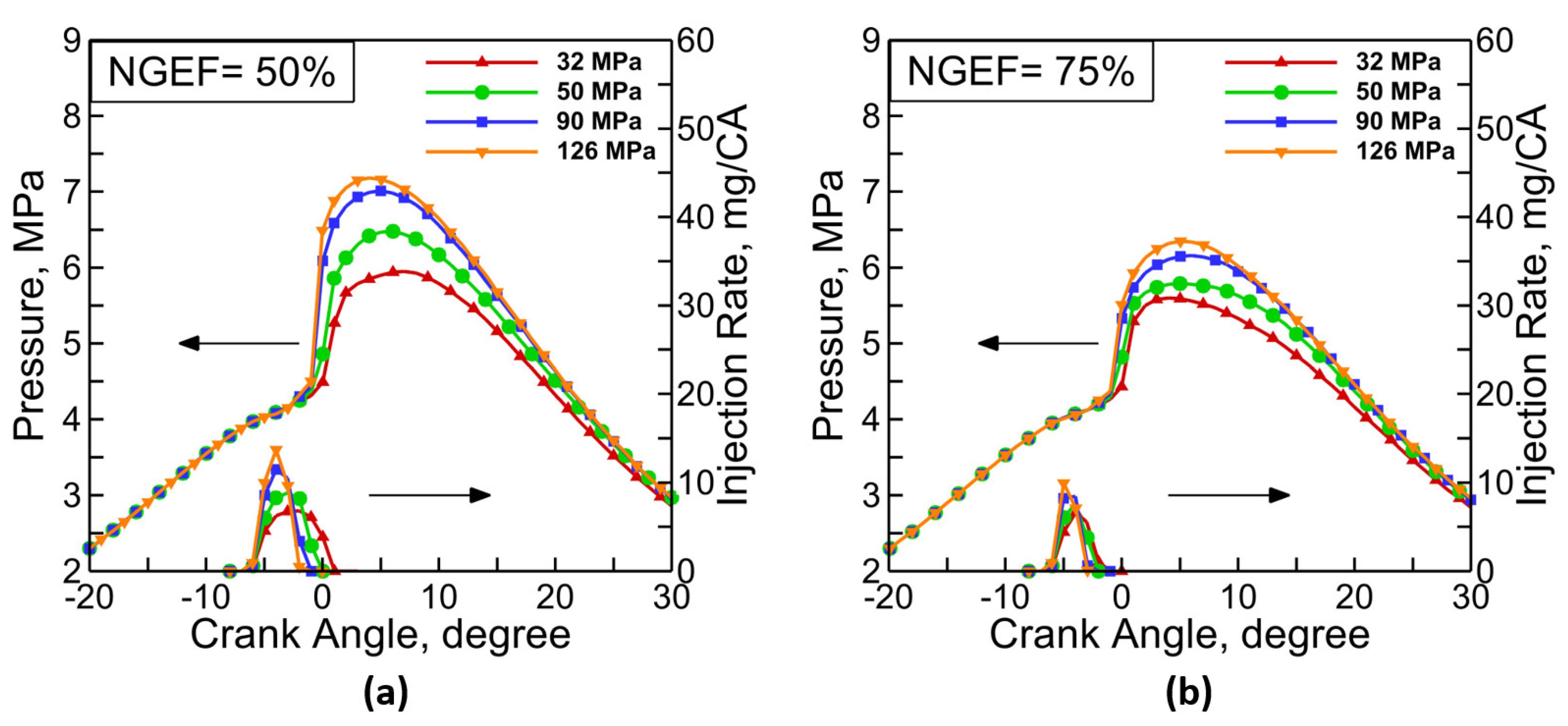
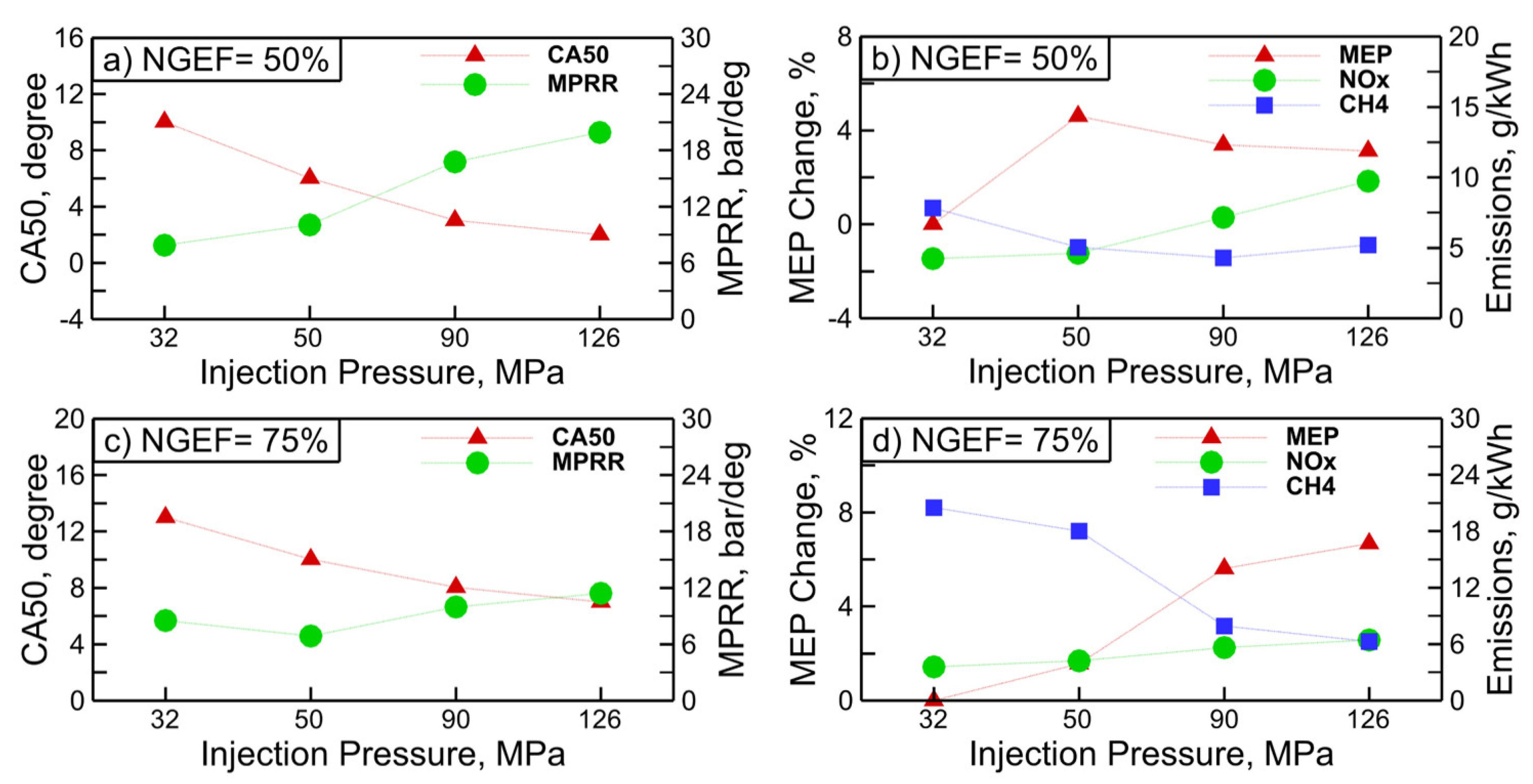
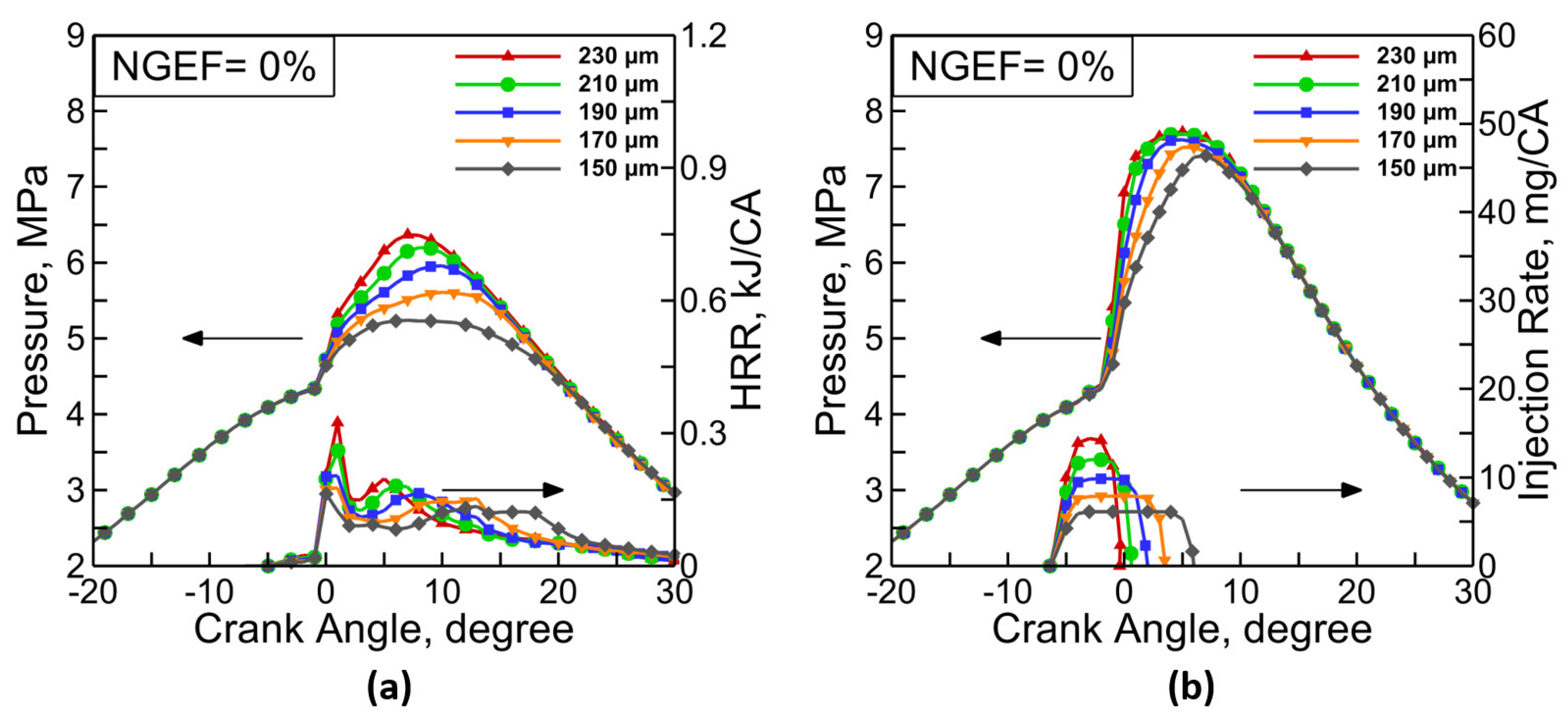
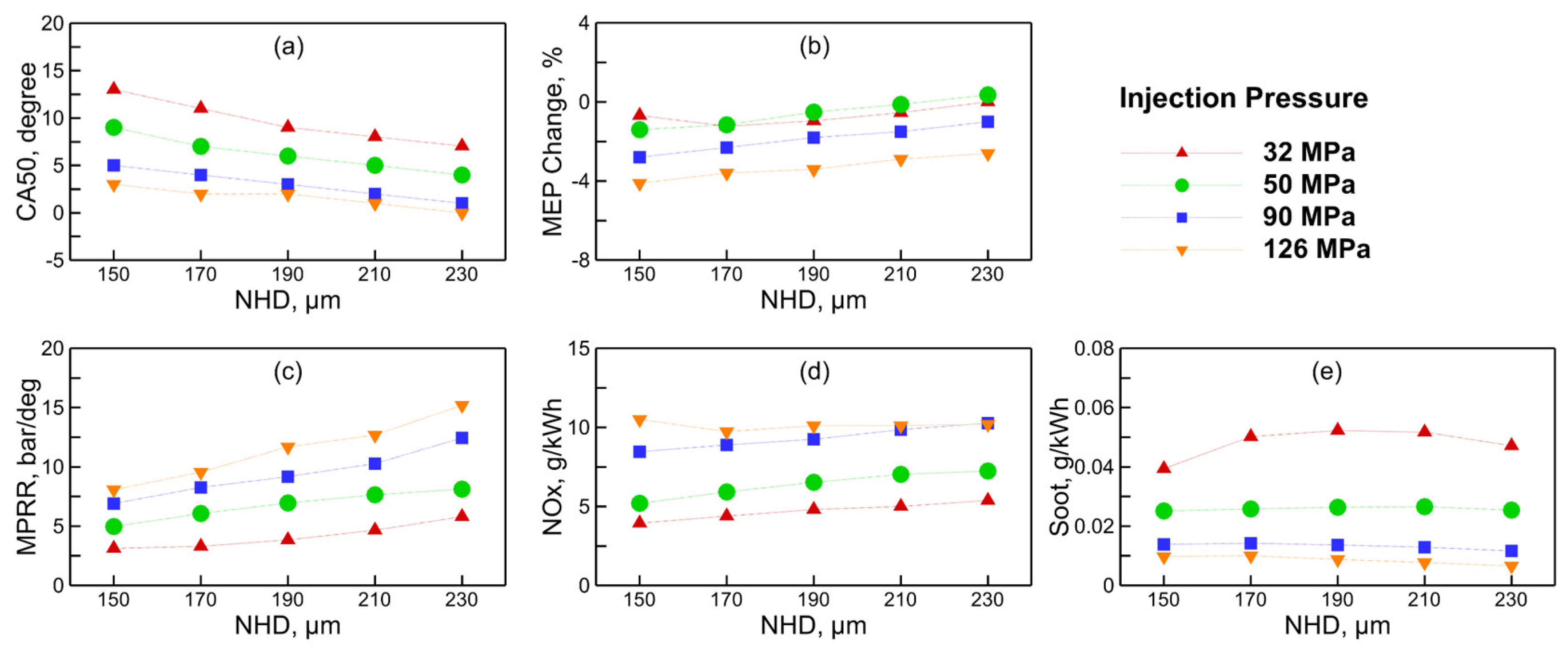
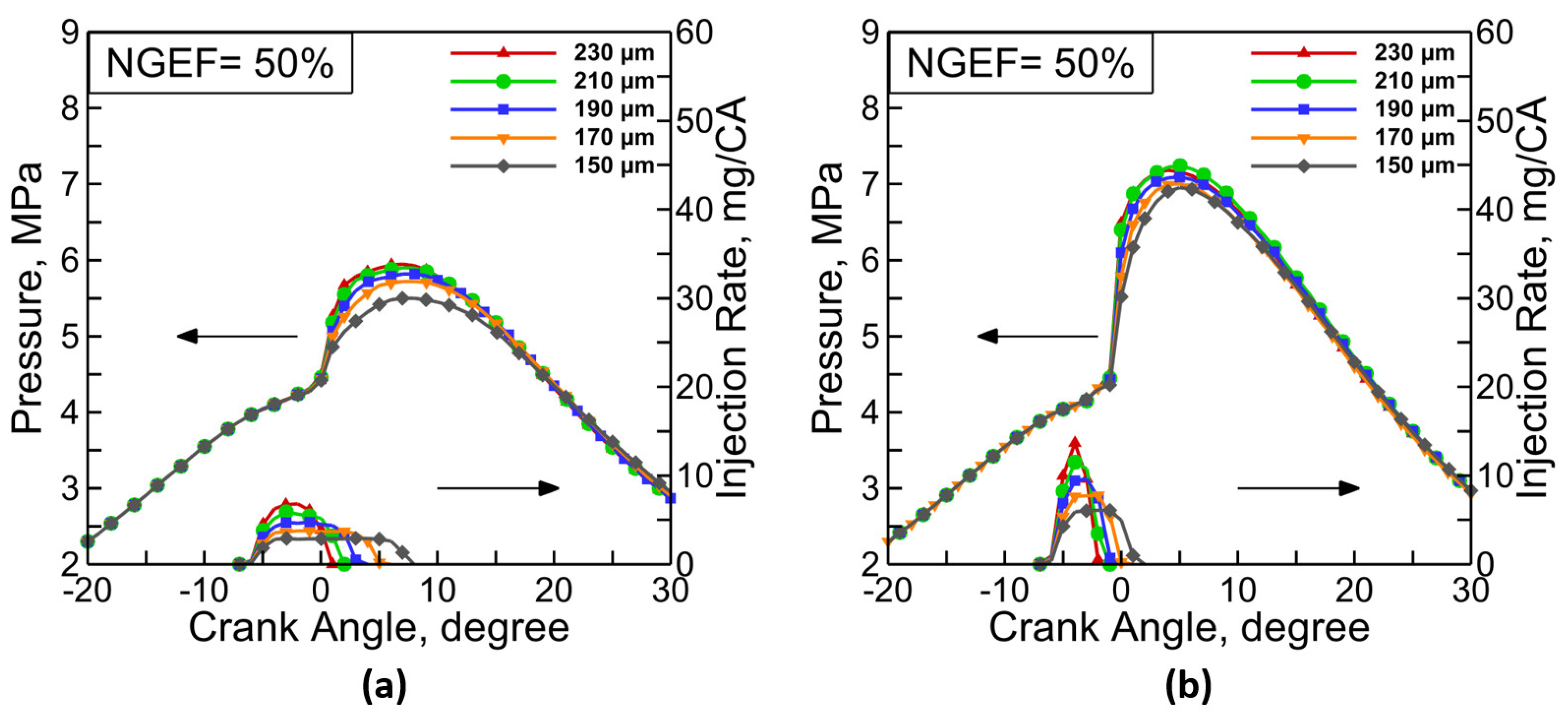
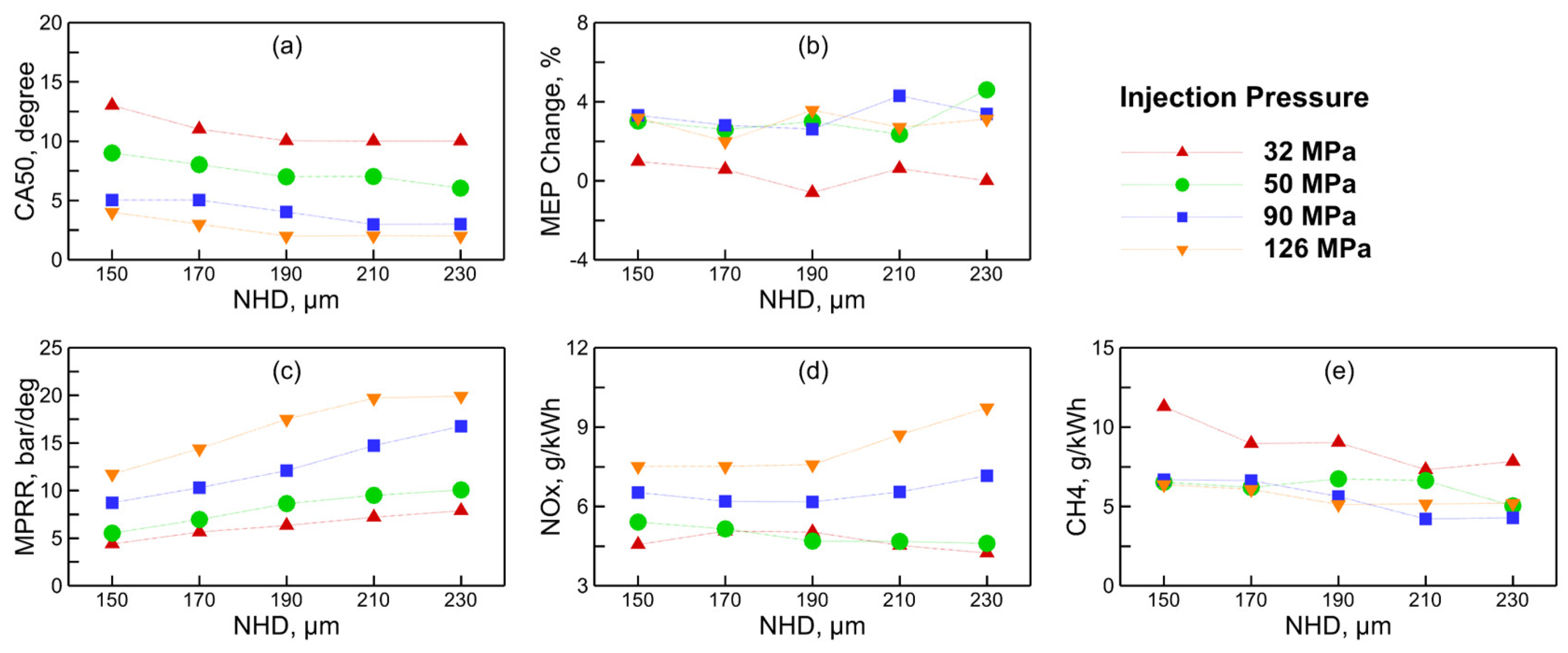
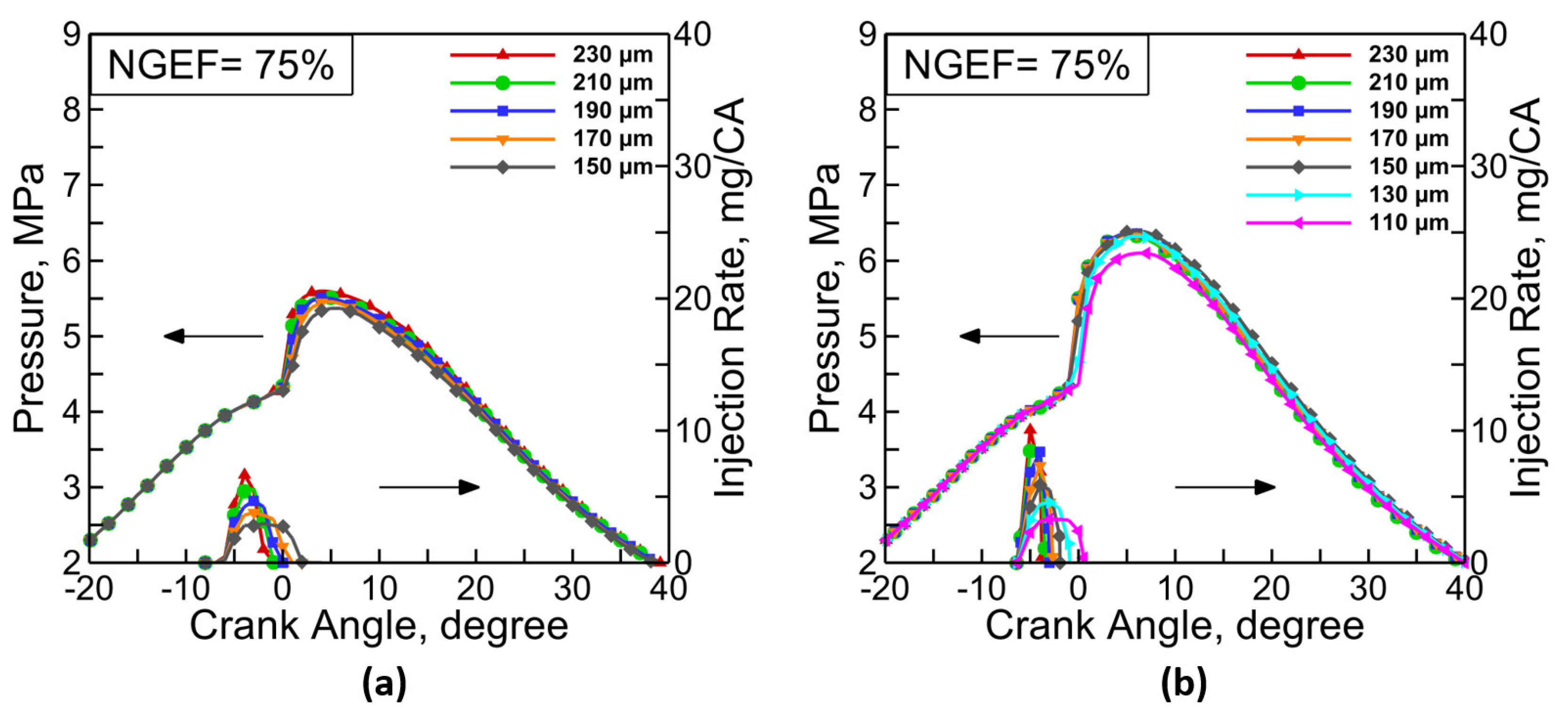

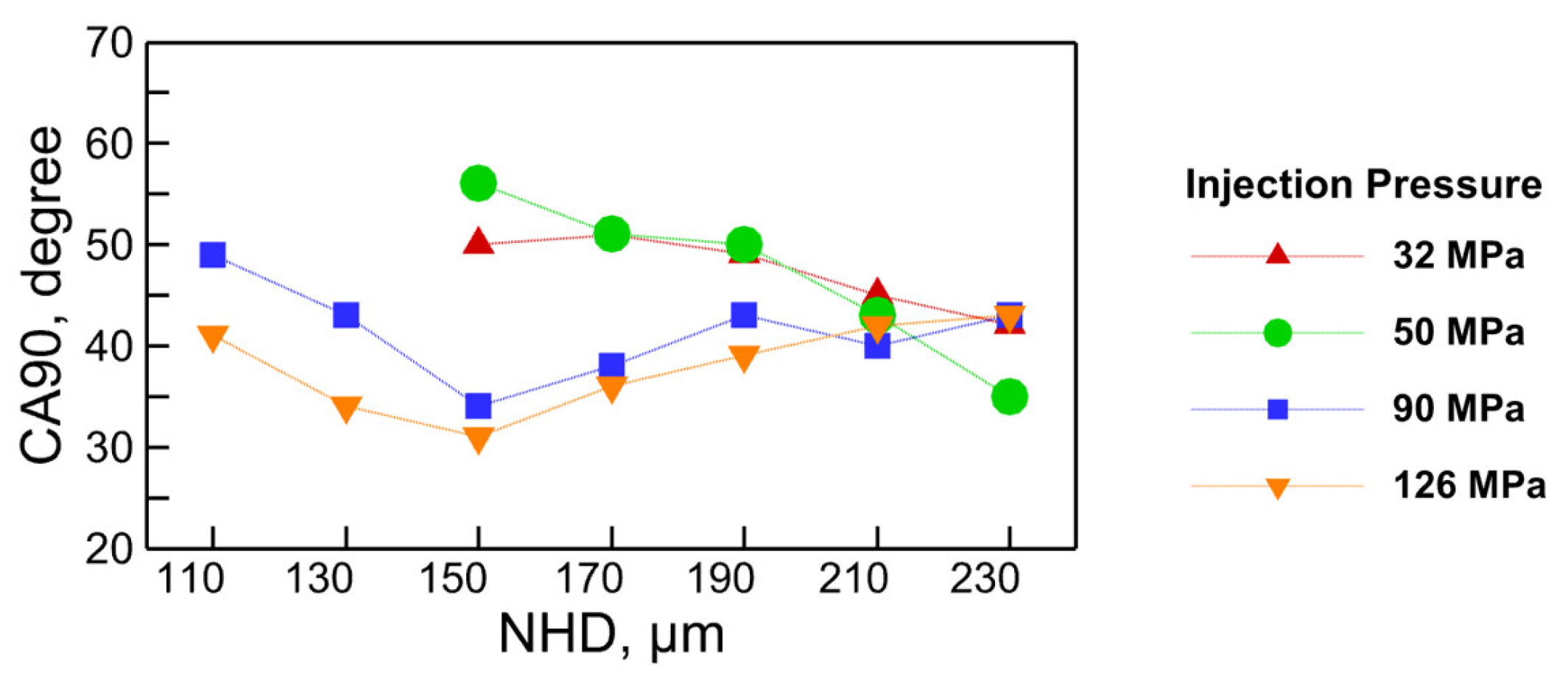

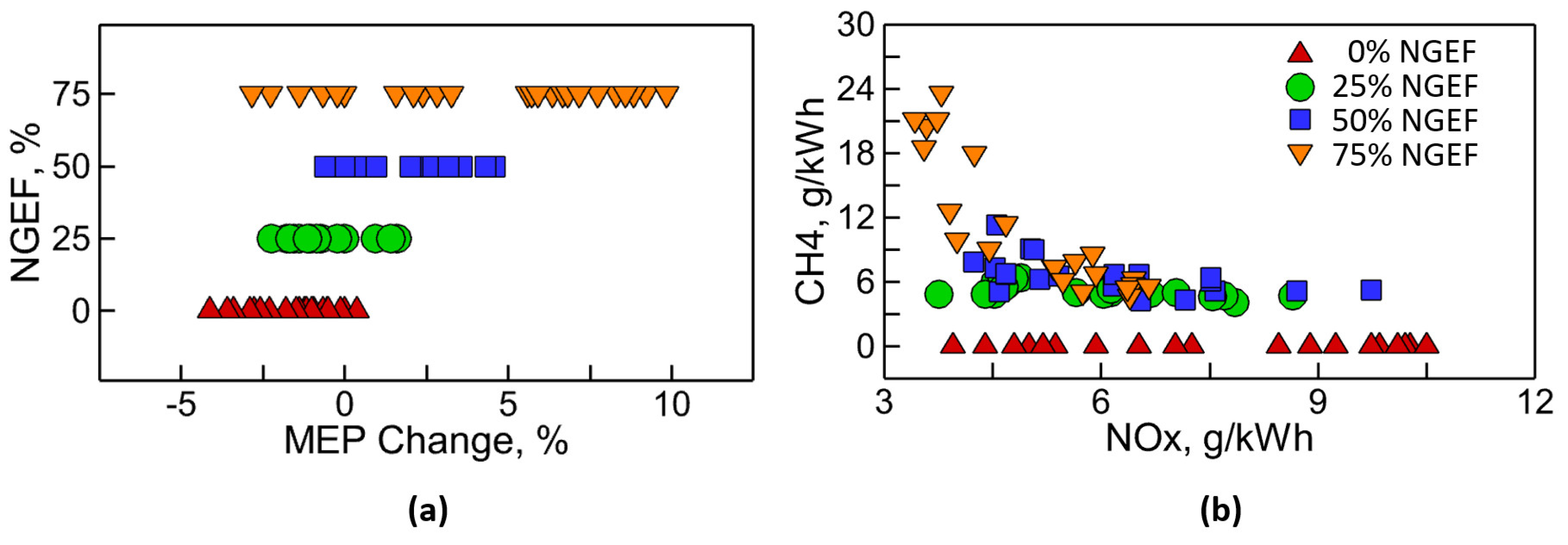
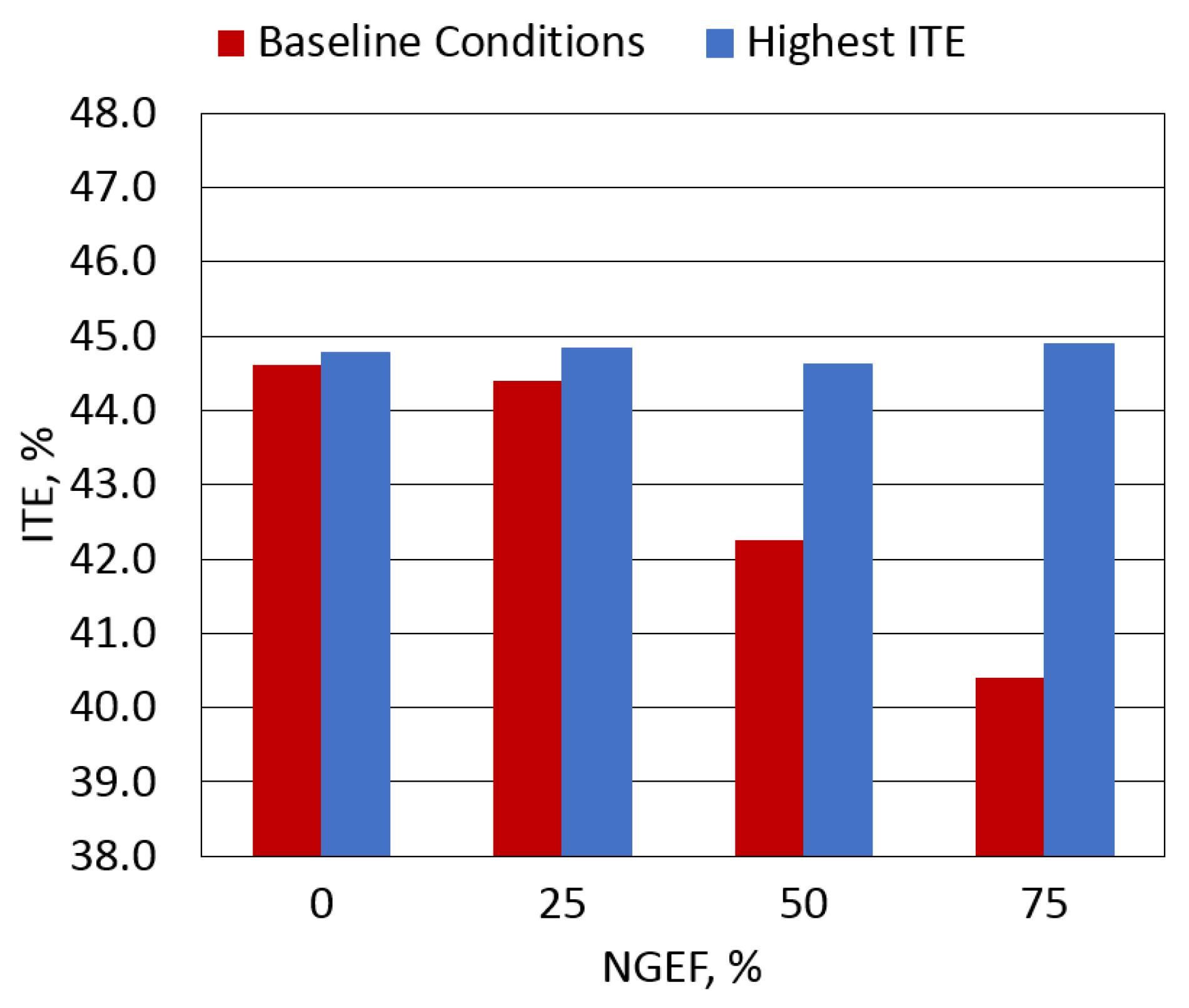
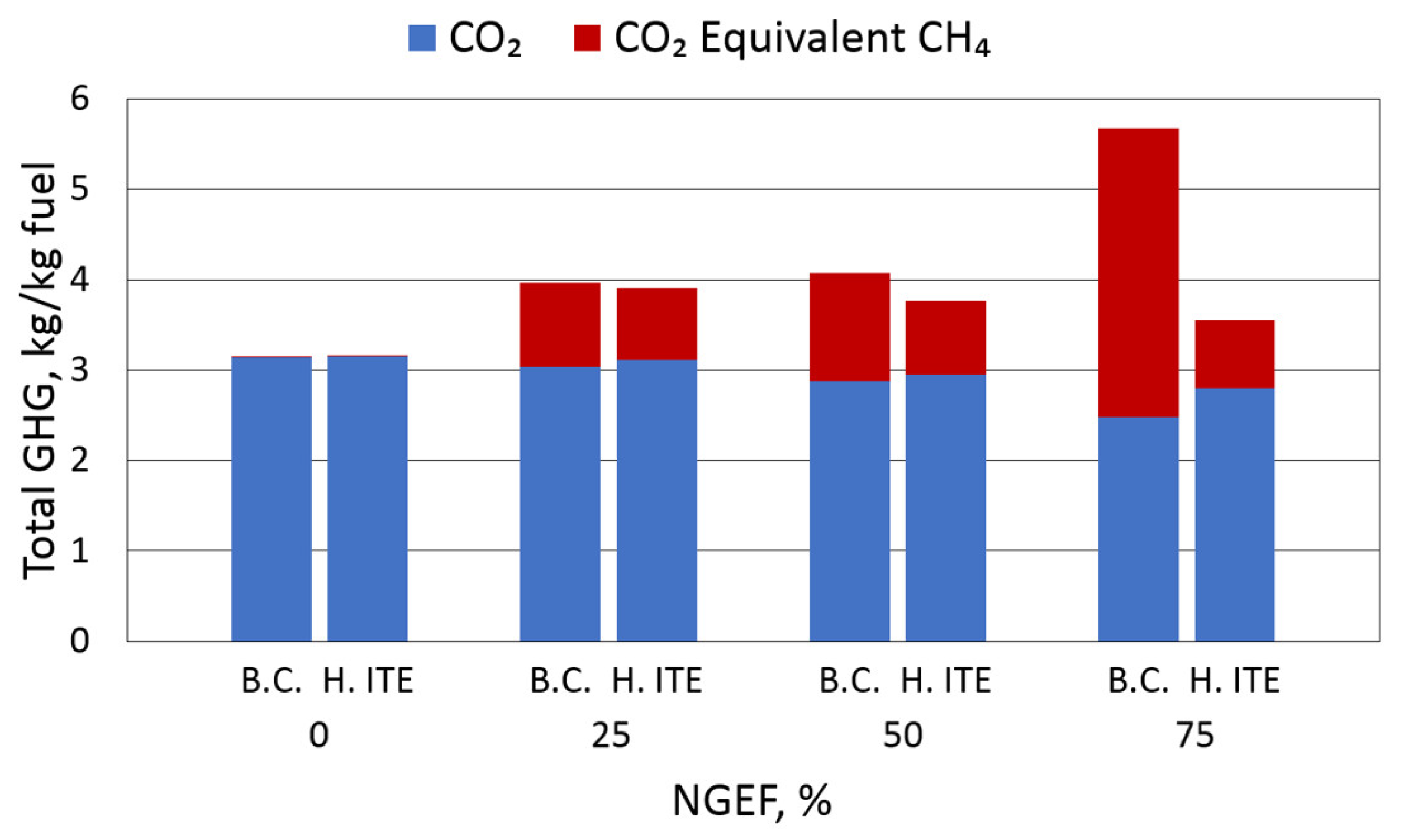
| Engine Specification and Operation Conditions | Value |
|---|---|
| Bore, mm | 137.2 |
| Stroke, mm | 165.1 |
| Displacement, liters | 2.44 |
| Engine speed, rpm | 910 |
| Compression ratio | 16.25 |
| Nozzle hole number | 6 |
| Nozzle hole diameter, μm | 230 |
| Intake valve opening, CA degrees | −358 |
| Intake valve closing, CA degrees | −167 |
| Exhaust valve opening, CA degrees | 145 |
| Exhaust valve closing, CA degrees | 348 |
| NGEF (%) | 0, 25, 50, 75 |
| Cetane Number | Density, kg/m3 | LHV, MJ/kg | H/C Ratio, mol/mol | |
|---|---|---|---|---|
| N-heptane | 54.4 | 685 | 44.92 | 2.29 |
| Diesel | 42 | 841 | 42.76 | 1.85 |
| Injection Pressure, MPa | NHD, μm |
|---|---|
| 32 | 150, 170, 190, 210, 230 |
| 50 | 150, 170, 190, 210, 230 |
| 90 | 150, 170, 190, 210, 230 |
| 126 | 150, 170, 190, 210, 230 |
| Injection Pressure, MPa | 0% NGEF | 25% NGEF | 50% NGEF | 75% NGEF |
|---|---|---|---|---|
| 32 | 4.7 × 10−2 | 1.4 × 10−2 | 7.1 × 10−3 | 7.5 × 10−4 |
| 50 | 2.5 × 10−2 | 5.1 × 10−3 | 1.8 × 10−3 | 2.5 × 10−4 |
| 90 | 1.2 × 10−2 | 1.8 × 10−3 | 5.7 × 10−4 | 1.6 × 10−4 |
| 126 | 6.6 × 10−3 | 9.1 × 10−4 | 2.5 × 10−4 | 1.5 × 10−4 |
Disclaimer/Publisher’s Note: The statements, opinions and data contained in all publications are solely those of the individual author(s) and contributor(s) and not of MDPI and/or the editor(s). MDPI and/or the editor(s) disclaim responsibility for any injury to people or property resulting from any ideas, methods, instructions or products referred to in the content. |
© 2025 by the authors. Licensee MDPI, Basel, Switzerland. This article is an open access article distributed under the terms and conditions of the Creative Commons Attribution (CC BY) license (https://creativecommons.org/licenses/by/4.0/).
Share and Cite
Durmaz, M.; Ergin, S. A Numerical Investigation of the Effects of the Fuel Injection Pressure and Nozzle Hole Diameter on Natural Gas–Diesel Dual-Fuel Combustion Characteristics. Energies 2025, 18, 1799. https://doi.org/10.3390/en18071799
Durmaz M, Ergin S. A Numerical Investigation of the Effects of the Fuel Injection Pressure and Nozzle Hole Diameter on Natural Gas–Diesel Dual-Fuel Combustion Characteristics. Energies. 2025; 18(7):1799. https://doi.org/10.3390/en18071799
Chicago/Turabian StyleDurmaz, Murat, and Selma Ergin. 2025. "A Numerical Investigation of the Effects of the Fuel Injection Pressure and Nozzle Hole Diameter on Natural Gas–Diesel Dual-Fuel Combustion Characteristics" Energies 18, no. 7: 1799. https://doi.org/10.3390/en18071799
APA StyleDurmaz, M., & Ergin, S. (2025). A Numerical Investigation of the Effects of the Fuel Injection Pressure and Nozzle Hole Diameter on Natural Gas–Diesel Dual-Fuel Combustion Characteristics. Energies, 18(7), 1799. https://doi.org/10.3390/en18071799






